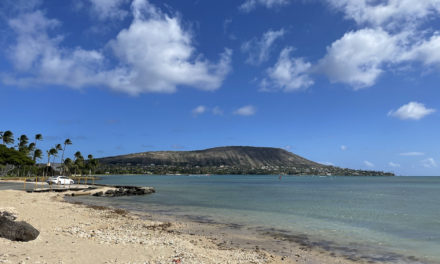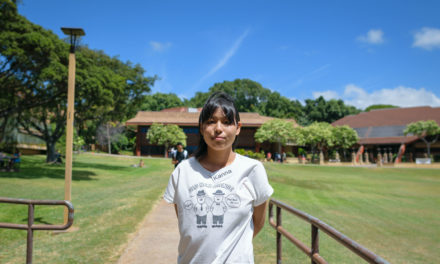Learn more about Black history in Hawaiʻi by watching “The Ball Method” about Alice Augusta Ball, the first African American to graduate from the University of Hawaiʻi. (Screenshot from “The Ball Method”)
By Christian Morgan | Contributing Writer
Black History Month began with the celebrations of the birthdays of Abraham Lincoln and Frederick Douglass, two individuals pivotal to the 1863 Emancipation Proclamation, a turning point of the Civil War. This history occurred not too long after African and African Americans first intersected with Hawaiians in the 1700s while laboring together for the whaling industry. Now, according to the 2020 American Community Survey Demographic and Housing Estimates, 3.6% of our Honolulu County population identifies as “Black or African American.”
Although Tuesday marks the end Black History Month 2023, I offer, from the perspective of a Black Honduran American born in New Orleans and raised in Texas and student of the University of Hawaiʻi as of January 2021, a few ways to continue celebrating Black history, culture, and people year-round:
Watch the short film “The Ball Method” on Amazon Prime
This film, directed by Dagmawi Abebe, tells the story of Alice Augusta Ball. In 1915, Ball became the first African American to graduate from the University of Hawaiʻi and first female to graduate from UH with a master’s degree in Chemistry. Her master’s thesis on ‘awa or kava impressed recruiters from the U.S. Public Health Service (Kalihi Health) and in 1916, Ball created an injectable chaulmoogra oil that helped to treat Hansen’s (leprosy) disease worldwide.
Join the Obama Hawaiian Africana Museum’s Betsy Stockton Book Club every 2nd and 4th Tuesday
Betsy Stockton was born a slave in Princeton, N.J. After being formally freed in 1817, she traveled to Hawaiʻi with Charles Samuel Stewart under an American Board of Commissioners for Foreign Missions (ABCFM) contract. When she arrived in Lahaina in Maui 1823, Betsy became the first American woman, and African woman, to set foot in Hawaiʻi. Before leaving in 1825, she helped establish our first schools.
Listen to the album “Wahi Mahalo” (on Spotify or Apple Music) by Kamakakēhau and support their upcoming documentary, Kamakakēhau: The Heart’s Desire
Born in Little Rock, Arkansas, African American Ryan Kamakakēhau Fernandez came to Hawaiʻi through adoption )(or hānai by the late Robyn Nae’ole. He navigates his belonging to Hawaiʻi with his West African ancestral homelands through traditional Hawiian mele (music) and o’lēlo (language).
Kamakakēhau is not the first African American to contribute to traditional Hawaiian music. According to the Hawaiian Journal of History, the King’s Band was formed in 1836 during the reign of King Kamehameha III and its first bandmaster was an African-American known as “Oliver”. Its second bandmaster was an escaped slave from Petersburg, Virginia named George Washington Hyatt. They were responsible for commemorating state events such as the funeral of Princess Nahiʻenaʻena. Kamakakēhau continues a legacy.
Dance a eulogy
Oyeza Cruz Banks is a dance anthropologist born in California with both Pacific Islander (Guåhan/Guam) and African American ancestry. In the film titled “Ocean in our Blood,” she dances for the late Teresia Teiwa, a poet and professor of Pacific Studies at Victoria University, renown for challenging anti-blackness in academia. In Bank’s paper for the Critical Stages/Scènes critiques (CS/Sc), an online, bilingual (English-French), open access, peer-reviewed journal published by the International Association of Theatre Critics (IATC), she says, she “[activates] a dance tradition of mourning the beloved dead that is practiced in both Black/African and Pacific contexts.”
I can relate, having danced second-line, a West African and Carribean tradition introduced to New Orleans through the Atlantic Slave Trade, at my grandmother’s funeral. Not every culture processes grief through dance, but using dance to process the loss of anything important you — a home, friend, memory — may be a beautiful way to relate to Black culture this month.
Gather Black student community
Dr. Akiemi Glenn, founder and executive director of the Pōpolo Project, began the project as a blog to record and share conversations she had with Black locals in Hawaiʻi, according to KHON2. Through this experience she learned the question of whether Black locals wanted to be in Black community is rather recent.
Historically, Black people have not experienced racial hatred in Hawaiʻi as they have in the continental United States and experience less pressure to unite based on racial identity for strength. To summarize the About page of The Pōpolo Project’s website, the nonprofit’s goal is to provide a space to redefine what it means to Black in Hawaiʻi while also reconnecting to our ancestry.
To continue Black History month beyond February, consider creating space for black students on KCC campus by starting clubs like UH Manoa’s 2016 established Black Student Association (BSA) or a college chapter of the Honolulu-Hawaiʻi NAACP.







